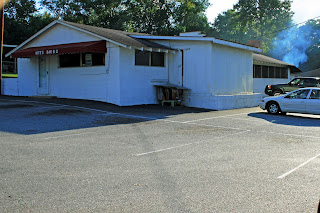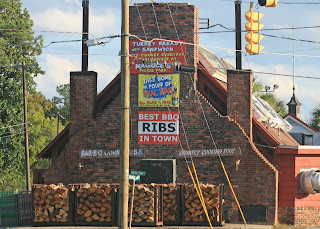High Marks. Hite's Barbecue occupies a small cinderblock building on a two lane road in West Columbia, SC. Note the smoke emanating from the rear of the building and the pickup, which obscures a large pile of wood by the back door.
It’s a shame to go to a ‘Q joint and plunk down good money for sorry meat. So how do you know if a BBQ place is good or not before having to pay nine or ten bucks for a plate? Below are some guidelines that have served me in the past. Think of your favorite place and see if it doesn't fit several of these criteria.
1) SMOKE. Al Gore be damned! There must be smoke, and to hell with the carbon footprint! Real barbecue is cooked with smoke, and the smoke has to come from good hardwood trees. You should see it, and smell it when you pull into the lot, or at least when you get out of the car.
2) WOOD. There should be a wood pile on the premises, and it should be used for cooking. Oak will pass, but Hickory is king. Mesquite will do in a rush if you’re out west. Other viable woods are apple and pecan, though these are scarce and expensive and usually only used to put a finish on the meat. Beware of “decorator wood” that is only for show where the pork is actually cooked on a gas flame.
Nice Rack. Decoraor wood outside Maurice's Piggy Park in Columbial, SC. The Barbecue is actually cooked next door.
3) FAT PEOPLE. Fat people love to eat and usually know good food when they taste it. If there are no fat people eating there, the food is probably only so-so. Beware of a restaurant filled with skinny people in exercise gear. Those people don’t know how to eat.
However, fat people can’t be the sole indicator. They sometimes indicate food that is simply cheap.
4) PORTABLE COOKING RIG parked outside. Serious barbecue cookers love to compete with their fellows to see who can make the best barbecue at a given time and place. This is where their skill is honed to a high art and where they learn secrets from other cookers about how to improve their product.
5) TROPHIES. If you’re gonna compete, you better be able to win at least once in a while.
6) PIGS. Like the ancient Minoans who worshipped bulls and kept images of them around house, True BBQ aficionados keep porcine totems around them. The more pictures, statues and stuffed pigs in the dining room the better the restaurant. One of my favorites is a sign hanging on the wall at Henry’s Smoke House in Greenville, SC. Inside the outline of a pig, it says, “People Eat People’s Meat."
7) COUNTRY MUSIC has to be playing on the speakers. Anyone who cooks pork in the presence of any other mode, except gospel or bluegrass has no sense of proportion.
8) PICKUP TRUCKS in the parking lot. A lot full of BMW’s indicates the pork is either too expensive or too artsy or both.
9) SAUCE ON THE SIDE, not on the meat. If they have to sauce the meat to make it palatable, there’s something wrong with it.
10) THE BUILDING. Don’t even slow down for one of those cookie cutter fancy brick and steel facades that look like they were built last year. Somebody has to pay for that building. Real barbecue cookers build the pit first and then as an afterthought put some kind of enclosure around it, perhaps getting the idea when they hear the first raindrops sizzle on the grill. Look for a simple wood or cinderblock building, preferably out in the country. The fewer lanes to the road that goes there the better. Extra points are given if it has tables in the yard or a porch to eat on. Barbecue is meant to be eaten outside where the smoke in the air enhances the smoke in the meat for a complete barbecue experience. Screens are optional.
11) THE MENU should have barbecue as the main, or only item. If the menu has the barbecue listed somewhere down there between the Fiesta Chicken and the Shrimp and Sausage Penne, It probably comes to the restaurant frozen in a tub or plastic bag.
12) A SINGLE ENTITY. Beware of chain restaurants. A man runnning a pit out in the country is free to live his dream. Chains come with a large beauracracy whose main job quickly becomes maintaining the status quo vs. making excellent food.
Saturday, December 25, 2010
Subscribe to:
Comments (Atom)

